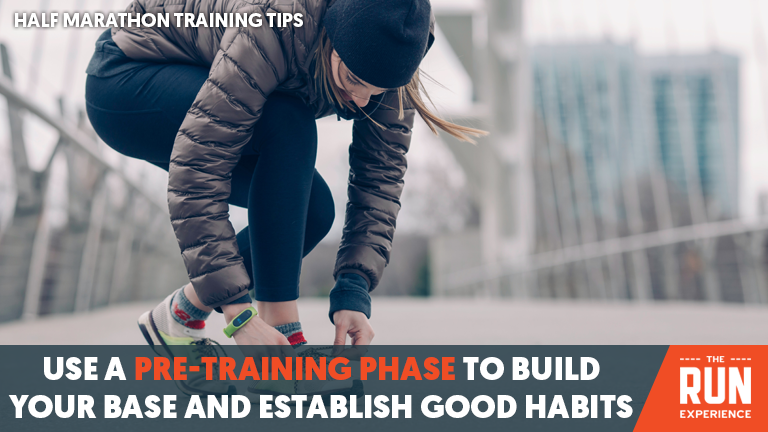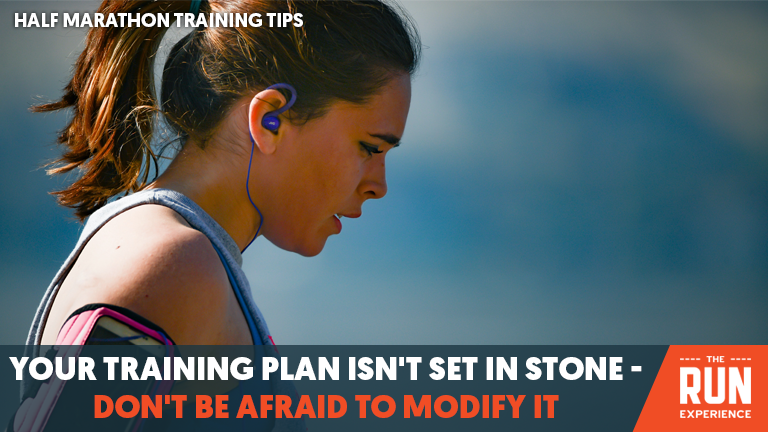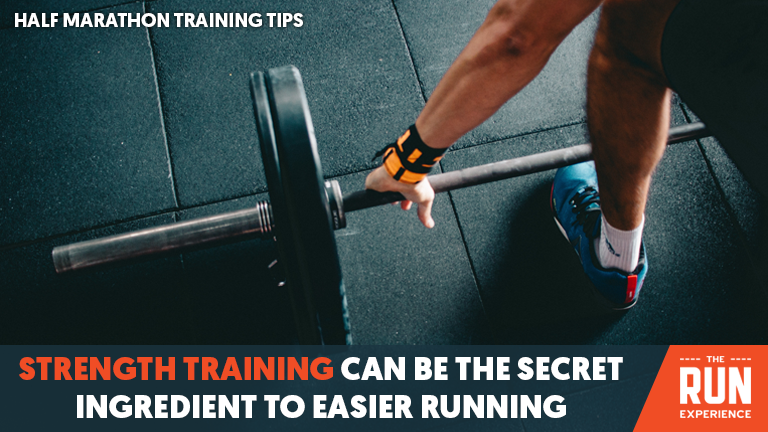Half Marathon Training Tips: Best Way to Prepare for 13.1
First half marathon? No problem. Learn half marathon training tips for beginners to learn how to train for a half marathon (the right way).

Training for your first half marathon? Congratulations! The half marathon race distance is a big goal for a lot of runners—it’s far enough to challenge your body and mind, without taking you quite as far as the full marathon distance.
If it’s your first half marathon it might seem like an intimidating ambition, but our half marathon training tips for beginners will get you ready for the race line in no time.
After all, you’ll need some structure to your training, you’ll probably want to venture into the world of sports nutrition and fueling, and the weeks ahead might include some of the longest runs you’ve done so far. Fortunately, we can help but those fears to rest. With the following half marathon training tips, we’ll walk you through three ways to train smarter, not harder.
Follow along and we’ll show you how to train for a half marathon (the right way)!
Half Marathon Training Tips for Beginners
Tip #1: Include a “Pre-Training” Phase
First off, don’t rush the process when you’re preparing to run a half marathon—it’s all about that base. Jumping straight into a training plan isn’t recommended due to the demands of the weeks ahead. The best way to train for a half marathon is to take it slow.
Learn how to prepare for a half marathon—from start to finish (which is what you’re already doing by reading this).

Taking four weeks or so before the start of your “official” training cycle can help ease in. Use this time to make sure you’ve got the appropriate level of fitness and endurance for your 12-16 week training cycle. This can be especially helpful for new runners to build confidence before tackling the training needed for your big race.
Build-Up Half Marathon Tips
Here are some things to consider in your build-up:
- Commit to 3-4 weekly training runs. Just 3-5 miles per run will do the trick to build you up to 9-20 miles per week. Experienced runners can aim for the higher end of the weekly mileage.
- Think about what habits you need to build into your training cycle. Getting to bed at a reasonable hour, having post-run fuel prepped and ready to go, and carving out time for daily mobility are all great starting points.
- Use the small aches and pains that come up along the way as the warning signs they are. Typically it means that your run form could use some improvement, whether that’s trying to improve your hip posture or open up your arm swing.
- Now is the time to make mobility a habit. Coach Holly has a video to guide you through a mobility routine in “Beginner Runners’ Guide to Stretching and Mobility.”
In addition to using this base-building phase to prepare your body, these can be the weeks to gather your gear:
- Running shoes: test out a few pairs at your local running store to find the right fit for you.
- Running clothes: make sure to have weather-appropriate clothing not only for training but also race day.
- Fueling: While your training runs in the first few weeks will be short enough that you might not need calories mid-run, you’ll probably want some form of nutrition as your training progresses.
- Nutritionist Coach Elizabeth breaks down how to fuel before, during, and after your run in her video Beginners’ Long Run Fueling Guide.
Tip #2: Have A Plan—But Make It Work For You
Don’t follow a plan. Let a plan follow you.

Now, we all have to start somewhere with our training. So maybe you did a search for a training plan, or you talked to your personal trainer about their half marathon training tips. You found a spreadsheet with all the columns filled out. Eight weeks from start to finish, with weekly workouts and runs all lined up, right? We’re not pointing any fingers, but it’s important to take that spreadsheet with a grain of salt.
After all, these training schedules are pretty generic. They don’t necessarily take into account your fitness level, your work and home life schedule, or the days that you wake up feeling less than stellar. When your training is laid out day-by-day, mile-by-mile, it’s easy to fall into a trap of thinking that you have to follow the plan to a T.
Instead, make the plan follow you with the right balance. Here are some tips to help you make that happen:
- Muscles are feeling sore? Spend some extra time mobilizing. Foam rolling and working on your range of motion can help limber up your muscles so they’re ready for the next workout. This can also be an important step to prevent common overuse injuries. Check out the following videos for some ideas:
- Runner’s Knee Pain | Symptoms, Treatment and Prevention
- How To Fix Shin Splints
- Your schedule calls for hills but you’re stuck in the gym on a rainy day? Try the treadmill or a cross-training workout instead.
- 20 Minute Follow Along Hill Workout
- Follow Along Bodyweight Workout
- Planning a vacation in the middle of your training cycle? Enjoy your time off, but don’t totally slack.
- How To Eat While Traveling
- 15 Minute Travel Strength Circuit Workout
DON’T BE AFRAID TO CHANGE THE PLAN.
Listen to your body and rearrange things accordingly. By all means, get the work in, but NOT at the expense of an early injury or poor running form. You can supplement your plan with cross-training, running on a treadmill, or mixing up your rest days depending on how you feel.
Tip #3: Running Isn’t The Only Way To Prepare For a Half Marathon
Don’t be fooled into thinking that getting better at running can only come from running more. This is a classic misconception that can often lead to excessive wear and tear on the body as well as overuse injuries. The great news is, you can build strength and skill as a runner through strength training as well as getting in those miles.

Strength training brings a variety of benefits:
- Build muscle by adding weight to movements.
- Start with bodyweight and add weight or load as you get comfortable. Adding just five pounds to your lunges will make running uphill feel that much easier.
- Develop hip stability, core engagement, and upper body strength to supplement your running.
- Adding supplemental movements such as glute bridges, planks, and push ups target strength for the whole body.
- Practice controlled breathing patterns while not under the stress of running.
- Taking big belly breaths by engaging the diaphragm can be difficult when we’re pushing the pace on a run. Instead, spend time consciously breathing while moving through a squat or when doing push ups.
- Moving under greater ranges of motion than you would use while running can help build stability and control.
- For example, a lunge puts your rear leg into full hip extension. When you run, your rear leg also goes into extension. By training lunges outside of running, you’ll be able to practice this range of motion without having to actually run. And as a bonus, you can improve your strength and muscular endurance at the same time!
Strength training just twice a week, for 20-30 minutes per day is all you need to gain access to a full range of motion and stable control in all of the joints being impacted by those miles- i.e. hips, ankles, knees, you name it.
Favorite Strength Exercises
Some of our favorite tried and true strength movements:
- Push-ups: A simple and effective way to find your midline, access your glutes, stabilize the shoulders…the list goes on.
- Squats: These strengthen the leg muscles that carry you through every stride.
- Lunges: These improve mobility, engage your core, and build leg strength.
- Planks: They engage your core, which helps you maintain good posture while running.
- Burpees: They are a great cardio activity to get your heart pumping and increase your cardiovascular ability!
The best part…you don’t even need a gym for most of this stuff! Try this follow-along bodyweight strength workout to see how simple it can be:
Bonus Tip: Prep For Race Day In Advance
Your weeks of training will give you plenty of time to think about race day itself. It doesn’t hurt to think ahead about how you’ll prepare for the starting line. Check out the video below for some of Coach Holly’s race day tips and logistics:
- Know your race course: scout out the course in person or check out a map so you have an idea of what to expect.
- Have a plan for race morning: use your race’s website to know what time you should arrive, where the start line and bag drops are, and where restrooms are located at the start and along the course.
- Get in the habit of including a dynamic warm up before every run and workout during training. Use that warm up on race day to lumber up, dispel any nerves, and get ready to run!
Mastering the Long Run
Long runs are the backbone of half marathon training — they build your endurance and mental toughness. Here's how to build up to those crucial 10-12 milers:
- Start where you are: Begin with a distance that challenges you but doesn't wipe you out completely. For many, that's around 5-6 miles.
- Increase gradually: Add about 1 mile to your long run each week. This gradual progression helps prevent injury and burnout.
- Run slow: Your long runs should be at a conversational pace — you should be able to chat with a running buddy without gasping for air.
- Fuel smart: Practice your race-day nutrition strategy during these runs. It's your dress rehearsal for the big show!
- Recovery is key: Give yourself plenty of rest after each long run. Your body adapts and gets stronger during recovery, not during the run itself.
Remember — you don't need to run the full 13.1 miles in training. Consistently hitting 10-12 miles will have you ready for race day.
Nailing Your Pace with Goal Pace Runs
Goal pace runs are your secret weapon for race day success. They teach your body and mind what your target race pace feels like. Here's how to incorporate them:
- Determine your goal pace: Be realistic based on your current fitness. Your recent 5K or 10K times can help you estimate a reasonable half marathon pace.
- Start small: Begin with 2-3 mile segments at goal pace within your regular runs.
- Build gradually: Increase the distance of your goal pace segments over time. Aim to include one goal pace run per week.
- Mix it up: Try "sandwich" runs where you bookend goal pace miles with easy-paced miles.
- Stay tuned in: Pay attention to how goal pace feels — your breathing, your form, your mental state. This awareness will be crucial on race day.
The Art of the Taper
Tapering is your chance to rest up and feel fresh for race day. Here's how to nail it in the final 2-3 weeks:
- Reduce volume, not intensity: Cut your overall mileage by 20-30% each week, but keep some shorter, high-quality workouts to stay sharp.
- Don't overdo the rest: It's tempting to become a couch potato, but light activity helps maintain fitness and manages pre-race jitters.
- Prioritize sleep: Aim for 7-9 hours per night. Sleep is when the magic of recovery happens!
- Dial in your nutrition: Focus on balanced meals with plenty of complex carbs. Save the big "carb-load" for 1-2 days before the race.
- Mental prep: Visualize race day success and review your race strategy. Confidence is key!
Remember, less is more during the taper. Trust that you've done the work — now it's time to let your body absorb it and get ready to shine on race day!
How Long Should You Train for a Half Marathon?
If you're eyeing that 13.1-mile finish line, you're probably wondering how long it'll take to get race-ready. The short answer? It depends — but we've got you covered with some guidelines to set you up for success.
For most beginners, we recommend 12-16 weeks of dedicated training. This sweet spot gives you plenty of time to build your endurance safely, without dragging on so long that you lose motivation. But here's the kicker — we're big fans of including a 4-week pre-training phase too! So your total prep time might look more like 16-20 weeks.
Why the range? Well, every runner is different. Your training timeline depends on a few key factors:
- Current fitness level: Are you coming off the couch or have you been running 5Ks regularly?
- Running experience: Is this your first rodeo or have you tackled a 10K before?
- Time available to train: Can you commit to 4-5 runs per week, or are you juggling a packed schedule?
Let's look at how this might play out for different runners:
- Brand New Runners: If you're starting from zero, aim for the longer end of the spectrum — about 20 weeks total. That's 4 weeks of pre-training to build a base, followed by 16 weeks of half marathon-specific training.
- Some Running Experience: Been running for a bit but never tackled a half? You might be good with 16-18 weeks total (4 weeks pre-training + 12-14 weeks of focused training).
- Experienced Runners: If you've got a solid base and have run long distances before, you could be ready in as little as 12-14 weeks total.
The Pre-Training Phase: Your Secret Weapon
We can't stress this enough — don't skip the pre-training phase! These 4 weeks are crucial for:
- Building a consistent running habit
- Strengthening your muscles and joints to handle increased mileage
- Testing out gear and nutrition strategies
- Mentally preparing for the journey ahead
Quality Over Quantity
Remember, it's not just about the number of weeks — it's what you do with them. A focused 12-week plan that you stick to consistently is way more effective than a 20-week plan where you're skipping workouts left and right.
Listen to Your Body
While these guidelines are a great starting point, the most important thing is to listen to your body. If you need an extra week or two to build up to longer runs, take it! It's better to arrive at the starting line slightly undertrained than overtrained and injured.
Frequently Asked Questions
Got questions about your half marathon journey? We've got answers! Here are some of the most common questions we hear from runners tackling their first 13.1:
How fast should I run my first half marathon?
Your first half marathon is all about the experience — not about breaking speed records. We recommend aiming for a conversational pace for most of the race. This means you should be able to chat with a running buddy without gasping for air.
Remember, the goal is to finish strong and smiling. You can always aim for a faster time in your next half!
What should I eat before a half marathon?
When it comes to pre-race fuel, familiarity is key. Stick to foods you've eaten before long training runs — your stomach will thank you! Some tried-and-true options include:
- Oatmeal with banana and a dollop of peanut butter
- Toast with almond butter and honey
- A bagel with light cream cheese
Aim to eat about 2-3 hours before the race start. And remember — race day is not the time to try that new energy bar or exotic breakfast!
How do I prevent hitting the wall during a half marathon?
Ah, the dreaded wall — every runner's nemesis. Here's how to keep it at bay:
- Practice your fueling strategy: Most runners benefit from taking in calories every 45-60 minutes during the race. Use your long training runs to figure out what works for you.
- Start slow: It's easy to get caught up in race day excitement and go out too fast. Stick to your planned pace, especially in the first few miles.
- Stay hydrated: Take advantage of water stations throughout the course.
- Mental prep: Break the race into smaller chunks in your mind. Focus on reaching the next mile marker rather than dwelling on the full distance.
Should I run the full 13.1 miles in training?
Nope! There's no need to run the full race distance before race day. Most training plans peak at around 10-12 miles for the long run. This distance is enough to build the endurance you need while minimizing the risk of injury or burnout.
Trust us — those last 1-3 miles on race day? You'll crush them with the help of taper, proper fueling, and good old race day adrenaline!
What should I wear for the race?
The golden rule of race day: Nothing new! Stick to clothes and shoes you've worn on your long training runs. Here are some tips:
- Layers: Depending on the weather, you might want to wear layers you can shed as you warm up.
- Chafe prevention: Use Body Glide or similar products on areas prone to chafing.
- Check the weather: But be prepared for surprises. Mother Nature loves to keep runners on their toes!
How long does it take to recover from a half marathon?
Everyone's recovery is different, but most runners need about 1-2 weeks to fully bounce back. Here's a general timeline:
- Days 1-3: Rest and light activity (walking, gentle stretching)
- Days 4-7: Short, easy runs if you're feeling up to it
- Week 2: Gradually return to normal training volume
Listen to your body — if something hurts, give it more time. And don't forget to celebrate your achievement!
Preparing for a Half Marathon
Put these half marathon training tips into practice and you’ll be prepared from the very beginning of your training program all the way to the finish line!
Don’t forget to download our mobile app to access full training programs (including our 8-week Half Marathon Program!), an active running community, and new workouts every week.
